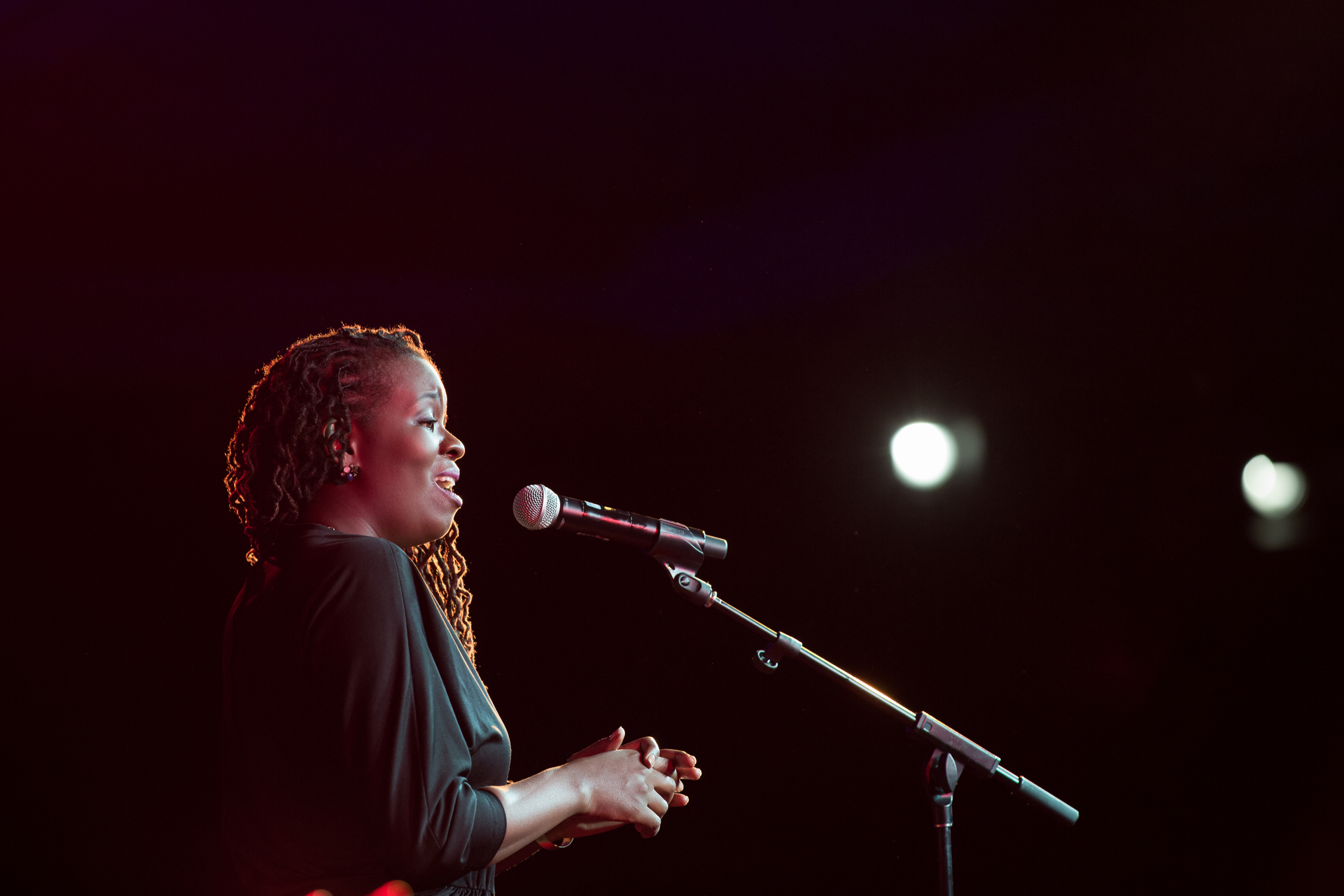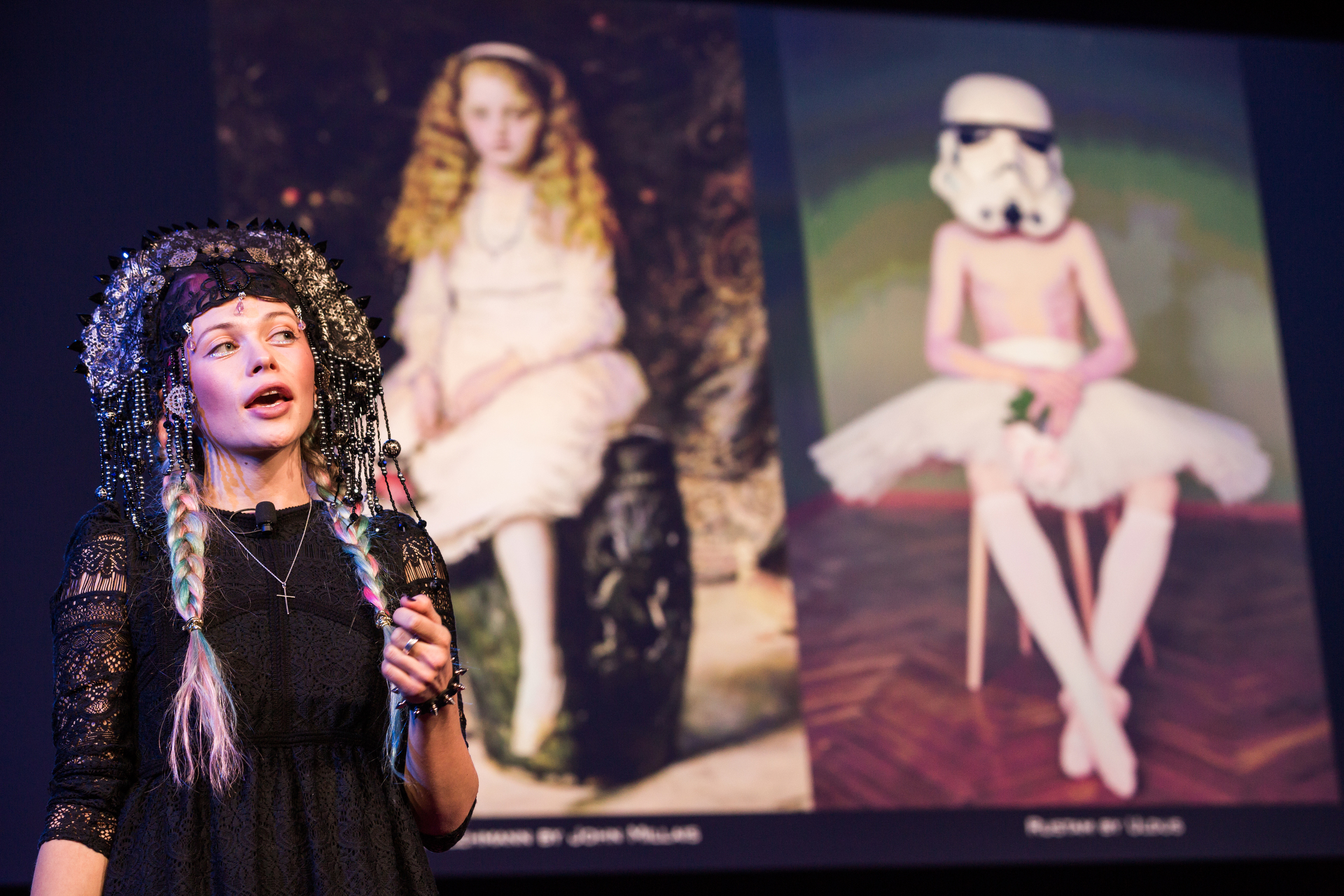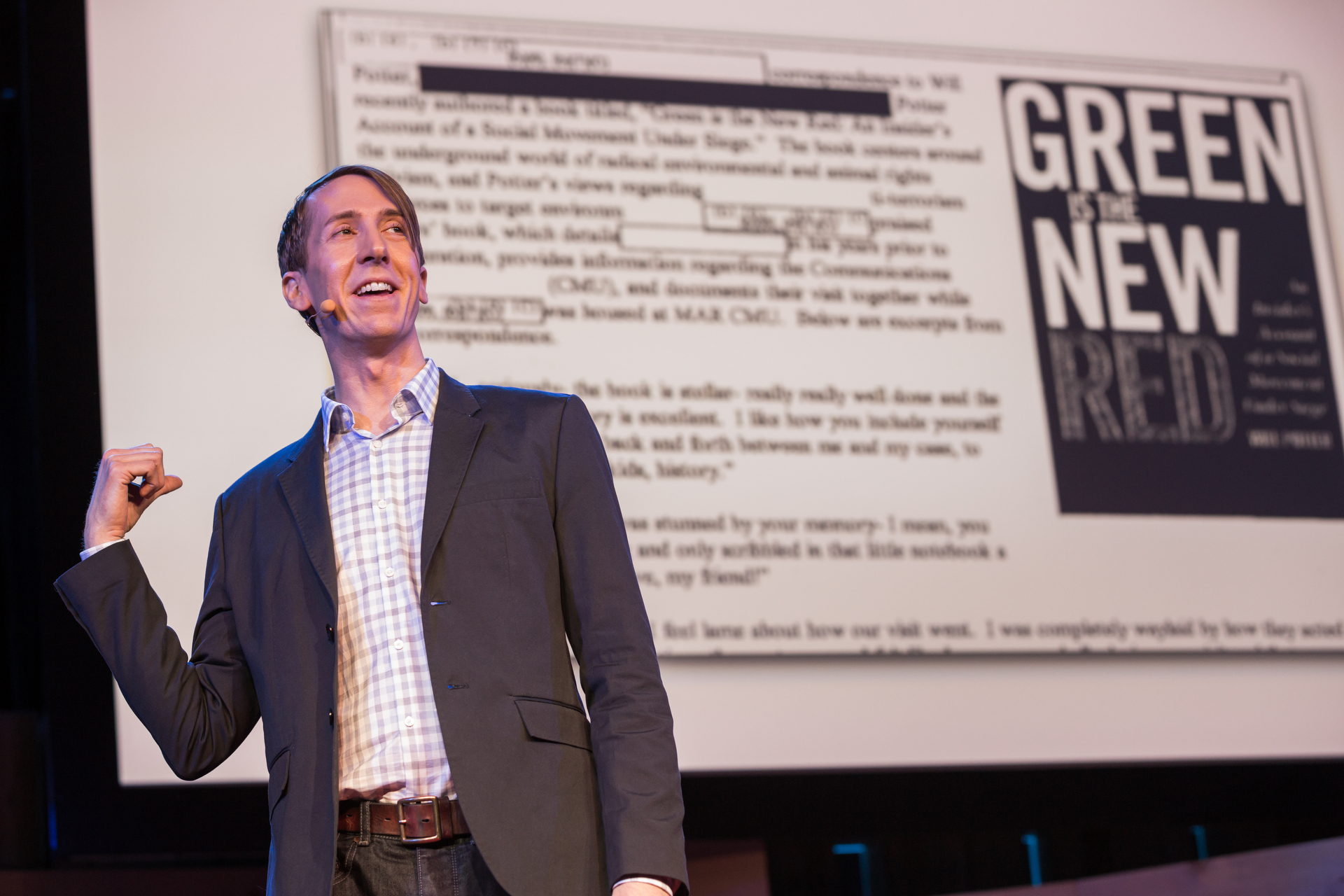Session 2 of Fellows talks at TED2014 was just as unexpected as Session 1. Here, read a recap of each talk in the session.
Somi, singer + cultural activist
East African songstress Somi brings her smoky voice to the TED Fellows stage, with “Brown, RoundThings for Sale” from her album The Lagos Music Salon. Often called a modern-day Miriam Makeba, Somi recently signed a recording contract with Sony’s relaunch of historic jazz imprint Okeh Records.
Steve Boyes, conservation biologist
“Wilderness cannot be restored or recreated, only destroyed,” says Steve Boyes. “We are about to lose our last glimpses into pre-history.” Every year, Boyes crosses Botswana’s vast Okovango Delta in an18-foot dugout canoe in a quest to preserve Africa’s last wetland wilderness. He undertakes this 220-mile research expedition to conduct a comprehensive biodiversity survey, benchmarking the wilderness against which to note future changes. Boyes and his colleagues are privileged visitors here: the only inhabitants of the Delta are the indigenous baYei people, who have accepted the researchers part of their tribe. The explorers enter baYei territory barefoot, unarmed, with minimal food — but with hundreds of pounds of high-tech equipment: the batteries, computers and solar panels required for research and to offer real-time data online with the public — “sharing the experience with people around the world to convince them to protect a place they’ll never visit.”
David Sengeh, biomechatronics engineer
Born and raised in Sierra Leone, David Sengeh witnessed the devastation of a war in which entire villages were destroyed and an estimated 8,000 men, women and children lost their limbs to amputation. As the country recovered, Sengeh was troubled to see that many amputees were not using their prosthetics, because ill-fitting sockets made prosthetics too painful to wear. Even in the developed world, it can take weeks or even years to procure a custom-made, single-material socket made the traditional way, with molding and casting. At MIT, Sengeh began developing a comfortable socket that can be produced quickly and cheaply, using magnetic resource imaging to get precise scans of limbs and finite element analysis to analyze stress and pressure points. With this data, his custom sockets can be produced anywhere using multiple 3D-printed materials that relieve pressure where needed on the patient’s anatomy. The new sockets are a revolution in prosthetic design, and is set to transform the lives of amputees the world over.
Eric Berlow, ecological networks scientist
Scientist Eric Berlow joined the TED Fellows specifically hoping to work with people outside of his own area of expertise. He was not disappointed: he worked with artist David Gurman on a project called We the Data about democratizing personal data, during which they reached out to experts on privacy and personal safety, including human rights activist Esra’a al Shafei and censorship activist Walid al Saqaf. Curious about other Fellows’ experiences with collaboration, Berlow recently polled the other Fellows about their collaborations, and mapped the answers. The resulting network map is startlingly dense and complex, especially given that the Fellows program is only five years old. Interestingly, 84% of the people involved had collaborated across disciplines, and many had not even met in person. Among tech, science and art projects, one collaboration stood out: in 2011, during the Libyan revolution, comics publisher Suleiman Bakhit worked with strategist Adrian Hong to evacuate tens of thousands of injured civilians to Jordan. The cloud-based interactive tool used to map these collaborations is itself a brand-new Fellows collaboration between Berlow, Gurman and Kaustuv DeBiswas, available browse at MAPPR.io.
Uldus Bakhtiozina, photographer + visual artist
Uldus Bakhtiozina’s images are simultaneously ethereal, surreal, funny and ironic as they upend identity, gender and cultural stereotypes. Working with photography, the artist captures the essence of people’s hidden inner lives and internal conflicts. The softly lit images from her project Desperate Romantics are inspired by pre-Raphaelite paintings of the 19th century. In one image, a 12-year-old boy — a professional dancer — wears a Stormtrooper mask and a pink tutu. He doesn’t tell friends at school about his dancing, hiding his identity in order to be socially accepted. In another image, a bearded bouncer named Nikita wears a collar of Barbie dolls, revealing his hidden vulnerability and romantic soul. “In Russia, it’s only acceptable for a man to look like an aggressive hulk,” says Uldus. And in a commentary on the culture of marriage in Russia, a self portrait depicts the 27-and-single Uldus standing outdoors in a wedding dress, her face obscured by a Mexican wrestling mask, “all desperate in my garden.” But irony is key, she says, preferring to motivate girls to be brave, fight for their goals and dreams, and to create magic.
Laurel Braitman, science historian + writer
Laurel Braitman, author of forthcoming book Animal Madness, grew up on a ranch amongst dogs, cats…and donkeys. Lots of donkeys. When baby donkey Mac was orphaned, he was given to young Laurel to care for until she didn’t have time. Miserable and confused back in his corral, Mac developed violent behaviors towards both people and animals, including himself. This early experience taught Braitman that humans aren’t the only animals to suffer emotional trauma. Fascinated, Braitman went on to study what naturalists in history have written about animal mental health, and has interviewed shelter workers, animal trainers, parrot therapists, people in Thailand who work with traumatized elephants, and many more people who work closely with animals. What she’s learned is that in both humans and animals, distress behaviors are essentially funhouse mirrors of healthy behaviors — overgrooming, overeating, and so on. “It’s another way of getting at something that Darwin argued for,” says Braitman, “Humans are different from other animals, but only by degree.”
Eman Mohammed, photojournalist
At the age 19, Eman Mohammed became the first female photographer in the Gaza Strip — a serious violation of taboo in a culture that discourages education and work for women. Her career choice created a stigma for her and family, photo agencies refused to train her, and her colleagues in the field made her unwelcome, once even going so far as to drive her to an open strike area and abandoning her there, waving and laughing as they drove away. It was not the first death threat she’d received. Facing the physical danger and prejudice inherent in her chosen career, she turned her lens to the lives of women and children in Gaza, her gender giving her access to this intimate world. Her images reveal lives considered inconsequential, unveiling poignant moments of joy and accomplishment despite an environment of ruin and violence. Witnessing this suffering and strength gave her the courage to overcome taboo and become “a witness with a choice — to run away or stand still.”
Andrew Bastawrous, eye surgeon + innovator
There are 39 million blind worldwide, 80% living in low income countries like Kenya. While many cases of blindness can be prevented or cured, there are few treatment options in remote areas. Seeking a solution, the opthamalogist moved to Kenya, taking equipment, vehicles and a team to set up 100 clinics in the Great Rift Valley. They found poor road conditions, patients too remote to reach, and power difficult to access. Realizing that more people in this region had access to mobile phones than clean water, Bastawrous created PEEK, a set of smartphone apps and mobile equipment to replace cumbersome hospital equipment. Now all that’s needed to reach eye patients is a single person on a bicycle, carrying a smart phone augmented with a 3D printed piece of hardware that allows direct retina examination. A solar-powered rucksack juices the phone, and the whole thing costs less than $500. Trained examiners transmit data to remote doctors, who can recommend treatment and follow-up. “It says something about the human race that we can develop cures but not deliver them,” says Bastawrous. “Now we can.”
Kathryn Hunt, paleopathologist
When she was diagnosed with rare and aggressive ovarian cancer at the age of 22, rather than derailing her lifelong passion for archeology, it became a catalyst for deeper research. Returning to university after treatment, bald and still foggy from chemo, her classmates regarded her with fear, pity and sympathy. Instead of flinching, Hunt wondered whether ancient Egyptians suffering from cancer got similar reactions. Hunt began researching cancer as an ancient disease, and discovered that it did have a real presence in antiquity, referenced as early as 1,500 BCE, and found in human remains from as early as 6,000 BCE. She has created a database of archaeologic evidence of cancer, and is finding such interesting patterns as a higher incidence of cancer in ancient middle-aged people than their contemporary counterparts. Studying cancer over thousands of years will likely raise interesting questions about how biology, culture and environment have affected the development of the disease, says Hunt, and help us better understand its prevention and treatment today and in the future.
Will Potter, investigative journalist
Less than a year after 2011, Will Potter, then a reporter at the Chicago Tribune, did some leafletting, figuring it was a “safe” form of activism. He was arrested, released, and later visited by the FBI, who threatened to put him on a domestic terrorist list if he didn’t agree to become an informant. Through this experience, Potter became obsessed with investigating and documenting how nonviolent environmentalists and animal rights activists are treated as the United States’ number one domestic terrorist target. He traces it back to 1985, when opponents of environmental activism created the term “eco-terrorist” as a negative PR campaign. The designation stuck and is now used to prosecute nonviolent activists, from the so-called Animal Enterprise Terrorism Act to ag-gag laws criminalizing people who document animal welfare abuses. The point is to invoke fear, but as a journalist he professes an unwavering belief in bringing truth to light. “Over and over throughout history people in power have used fear to silence dissent,” he concludes. “It’s time to strike a new note.”
Kitra Cahana, vagabond photojournalist + conceptual artist
As a child, Kitra Cahana dreamed of running away, of foraging for berries and meeting strange people living life on the road. Now the fantasies of her youth have become reality in her work as a documentary photographer. Living among nomadic communities across the United States, she chronicles a different kind of American dream — one that eschews the trajectory of school, job and security for the freedom of traveling by freight train and hitchhiking, seasonal work, sleeping under stars, and spending time on creative endeavors. Nomads, tramps, vagrants, runaways — some of her subjects take to the road on purpose, while others have no choice. Her photographs capture the darkness and danger, too: addiction, exposure, and social discrimination. In some cities, it’s a criminal activity to sit on a sidewalk, sleep in a car, or even offer food to a stranger. Why would anyone choose such a life? The answer is as varied as the people who take to the road, says Cahana, but the travelers often respond with a single word: freedom.
Shih Chieh Huang, artist
Shih Chieh Huang animates everyday stuff with the stuff of life. Born in Taiwan, Huang grew up surrounded by hardware stores, as well as the lights, energy and toys of the night market. He enjoyed taking toys apart, and building environments with everyday household objects — plastic sheets and bags, Tupperware, highlighter ink — in which others could explore and play. Later, his creations evolved into elaborate devices that worked with body parts. He’d use video footage of eyeballs to trigger sensors for animated sculptures, or strap flashing, blinking artworks to his own body, filming his belly button to see it squirm. Huang’s more recent installations are inspired by bioluminescent underwater creatures. “I’d like to share how ordinary things can become something magical,” he says, as a large, anemone-like creature floating near the corner of the stage slowly lights up with multicolored LEDs. Its plastic-bag tentacles inflate and undulate softly in a rhythmic dance, exposing an electronic underbelly tangled with guts of glowing plastic bottles, wires, lights, mesmerizing the silent audience.
Susie Ibarra, Usman Riaz, + Somi
To close this year’s Fellows talks, Susie Ibarra, Usman Riaz, and Somi return to the stage to perform trio new collective composition, stemming from an original composition by Ibarra, “Belief” (“Paniniwala” in Tagolog). With Riaz on piano, Ibarra on percussion and Somi on vocals, the piece was composed, arranged, and performed as a collaboration by the trio.



Comments (3)
Pingback: From an eye exam on your phone to bioluminescent sculpture that looks alive: A recap of the TED2014 Fellows Talks, Session 2 | TEDFellows Blog